

Viking
1/4 scale Resin Kit from Fort Royal Review
Article in Military Modelling Magazine in 2000
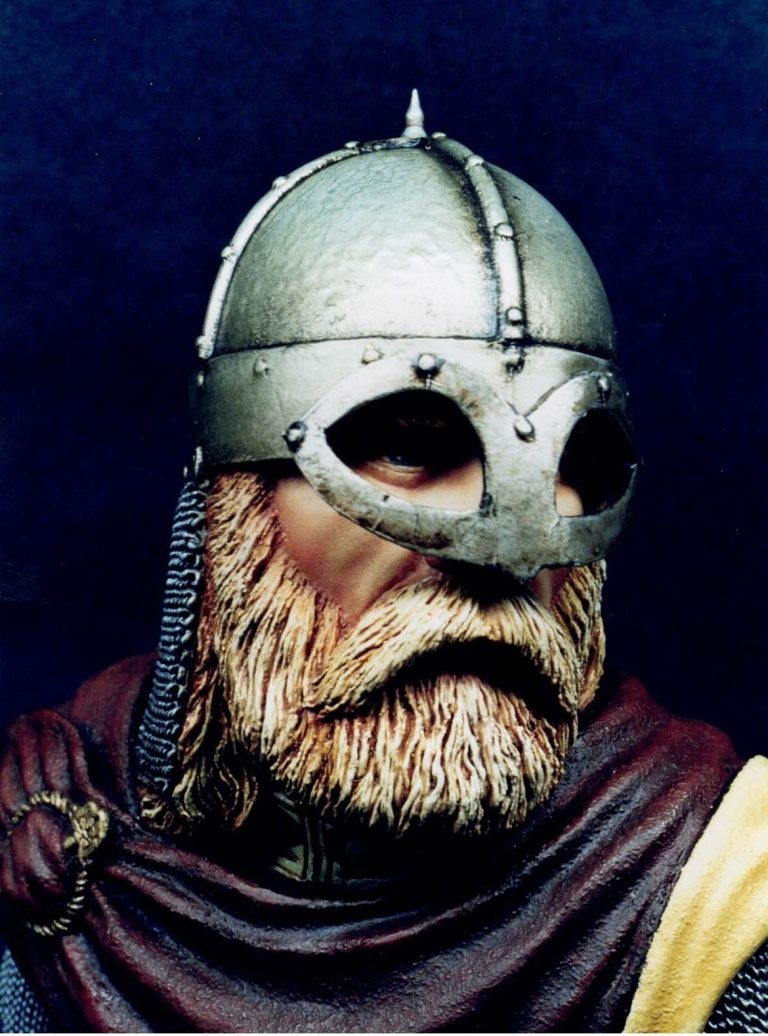
A Little History
The general view of the Vikings was one of large bearded chaps running up beaches, despoiling villages and monasteries, kidnapping for lascivious use, any available women, and pinching all the gold and silverware. Not exactly the ultimate in role models.
But then again, maybe they weren't getting the best image assessors to give them a fair write-up. After all, the historians of the day tended to be the monks and merchants, in other words those most sorely hit by this race of thieves and villains. Perhaps then it's worth a closer look.
First of all, what is a Viking. Well in the historical sense it's a person of Scandinavian persuasion, what is now Denmark, Sweden and Norway would all probably had their share of "Vikings", in fact anywhere around the Baltic area could be said to house them, as the Vikings didn't have a set country of origin as such.
The Vikings were definitely the raiders named as such in history, but they were also accomplished farmers, who not only raided foreign shores, but settled their own people on these new shores too.
They were also very good at trade, the fact that they were far travelled helped in this, and they were known throughout Europe from the Eastern Mediterranean to Russia and Greenland, possibly even as far as North America.
The term Viking could possibly come from one of many sources. The word "vik" means bay or creek which they are known to have used as their homes, whilst "vikya" means to turn aside possibly pertaining to the wandering of this people. "Vikingr" is a pirate or a robber, whilst "Viking" itself is th expedition itself.
Vikings were not usually vast armed forces, although there are documented cases where massed attacks were undertaken, the Viking is more often recognised as a band of men in a single or possibly two or three ships, landing on a foreign coast to either raid or trade for goods.
The "Viking Age" so to speak lasted for about three hundred years, which I suppose is a long period in which to get either liked or disliked as a race.
The historians of the day will always have the last word, and that's how a race or country's people are remembered.
Until of course someone digs a little deeper to study the truth of the matter. I've not really done that here, but I'll leave you to take the interest further should you feel moved to, after all, it's a very interesting period in history, that whilst still sketchy in places, does evoke mysteries of its own.
As for this model, the helmet is the "star of the show" being based on an archaeological find. In this case it is the rather badly damaged Gjermundbu helmet.
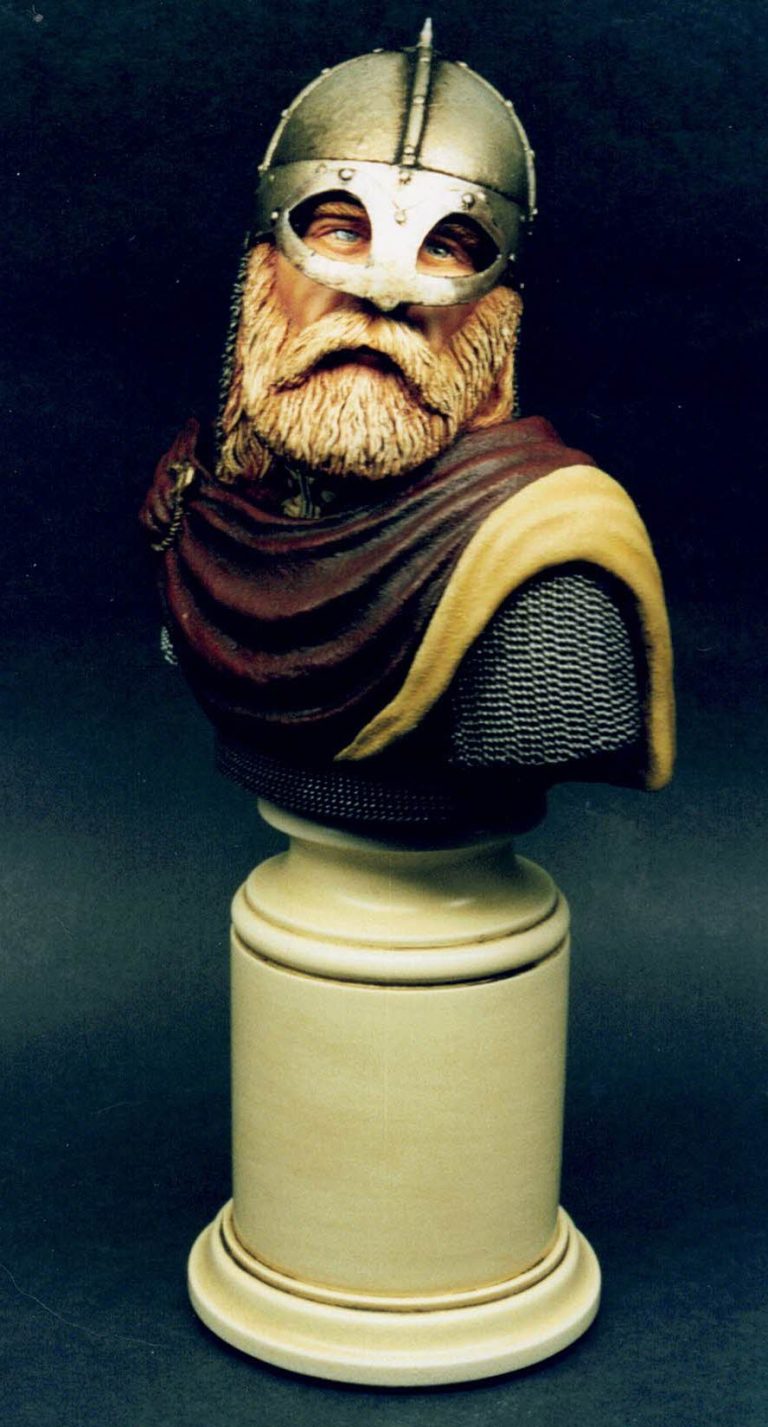
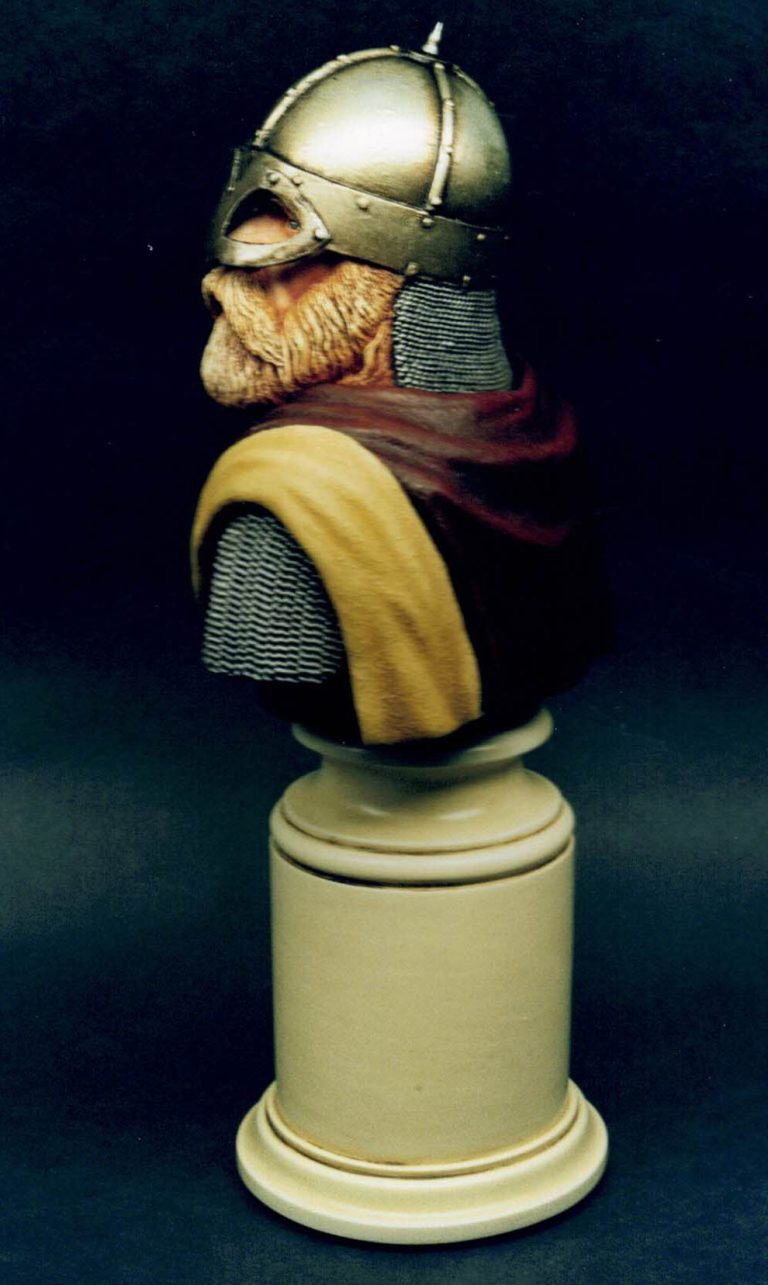
This is a functional helmet which is well engineered for protecting the head of the wearer from weapon blows. The riveted construction would be comparatively easy to construct, compared say to a helmet of the Sutton Hoo or even Roman Legionary design, thus negating the need for an extremely accomplished armourer. And it lacks the decorative qualities of the Coppergate helmet, so is more likely to be a helmet from the "rank and file" as opposed to a chieftain or leaders piece.
The preserved helmet is in rather poor condition, but still retains most of one half of one of the sides and crown, the brow band and the spectacle face guard, thus showing how it was constructed. How the helmet came to be in this condition, was it damaged before it was buried or lost ? or has time simply taken it's toll ? is best guessed at as yet. It is still a good example of a relic from a time gone by, and one worthy of depiction in model form.
The Bust
Since Dave Gerrett and Pete Morton parted company at the end of 1998, splitting the range of their large scale busts up to be marketed separately ( dependant on who did the major part of the sculpting of each ), it has I suppose been inevitable that one of the sculptors would decide to replace one of the busts that they "lost". This especially being true when the initial idea of the busts was to display them as pairs, for example the Saxon and the Viking, others which would have ( and may yet appear ) being a Cavalier to go with the Roundhead, and a Celt to go with the Roman.
Following this line of thinking then, I would say that it was only fair to say that any "replacement" would be compared to the former depiction of the model, and hence the reappearance of a few shots of the Pete Morton version of the Viking.
A quick note on Pete's version, that being that I've returned to this model to change the base, not only because I like the new colour, but because I feel there is a fairer comparison between the two if there is little or no difference between the bases.
Right, you might be fair in thinking that at some point in this article I'll be postulating as to which of the models I prefer, which is better, more accurate etc. Well I'm sorry but I'll be disappointing you on that one. Not just because I enjoy the friendship of both sculptors, but simply because I do genuinely like both pieces. Fair enough if you'd like to talk about accuracy, you could say that the helmet on the newer model is more accurate because of the extra rivets holding the brow band to the rest of the helmet which would have to be there to hold it from splitting apart the first time it was hit with something.
The helmets are both based on the Genmundbu helmet, my references coming from the Brasseys "Barbarian Warriors" which show a picture of the probable form of the pieces making up said helmet, these being without those rivets.


So on that point take your pick. Personally I think it'll come down to two simple things. These being that if you like only one of them then your decision is simple. If on the other hand you like them both, then you are going to be governed by the following :- can you a) Afford them, and b) Get hold of them. I make this latter comment because, as far as I know, the original bust is only available through VLS of America, and Europeans might find sourcing one of these a little less easy than you'd think.
Anyway onto the model in question. As has become standard with this line of busts the 1/4 scale is set to be surprisingly large and hefty when you get old of the model, the pieces being cast very cleanly in a mid-grey resin.
With this model there is the addition of a white metal spike for the helmet ( watch this because it's rather sharp ) and a softer more pliant piece of sand coloured resin that forms the "spectacle" face guard.
The only mould line I could find was about two inches long and placed on the corner of the cloak on the right shoulder below the flap of the cloak fastener.
This is easily enough filled with Milliput, but how do you get the textured finish. I asked the man himself - Dave Gerrett, who said that he used ready mixed filler, stippling this on with an old brush. I did this, mixing it with some wood glue to provide it with a little more "stickiness" and it worked a treat - thanks Dave.
The helmet I decided to do with foil, as per the first Viking. But as I'm on a diet, I elected to use something other than toffee foil. To the rescue came a friend who has been a keen modeller of aircraft for many years ( although he is seeing the light somewhat and attempting the odd figure or two ). He supplied me with a couple of samples of foil.
First up was a brand called "Bare Metal Foil" which is used by the aircraft makers on aluminium airframes to depict unpainted metal. This product is American, but it's probably available through Hannants over here. Advantages over toffee foil being that its a lot softer, although about as thick, and it's also self adhesive.
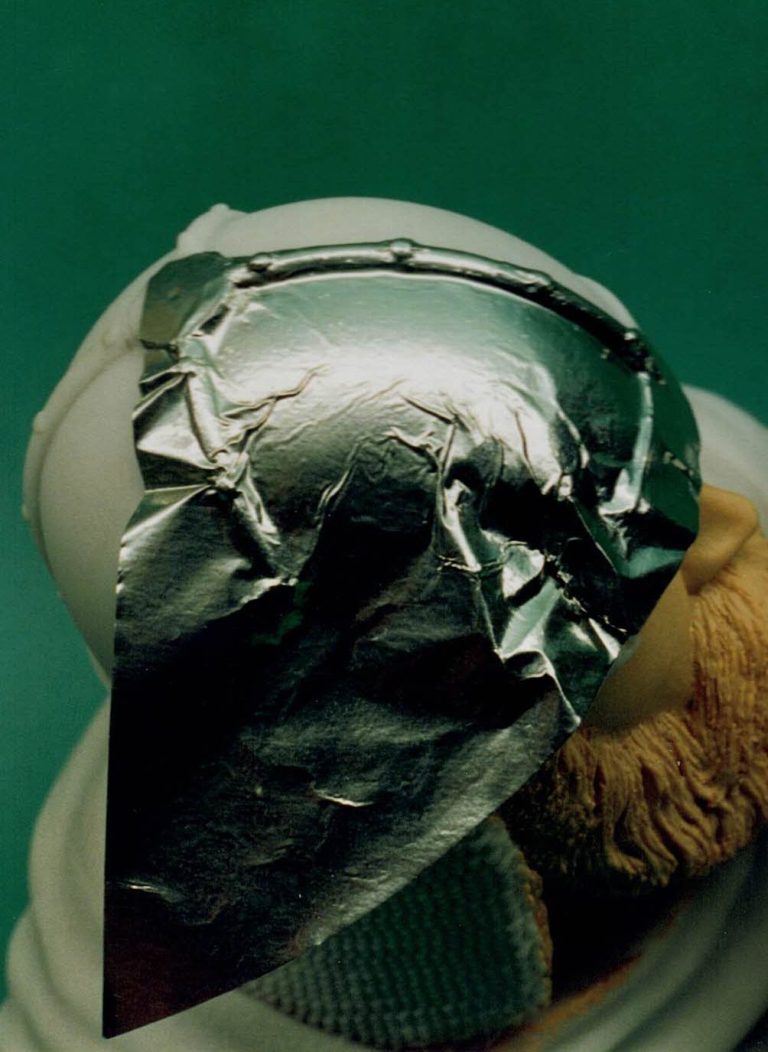
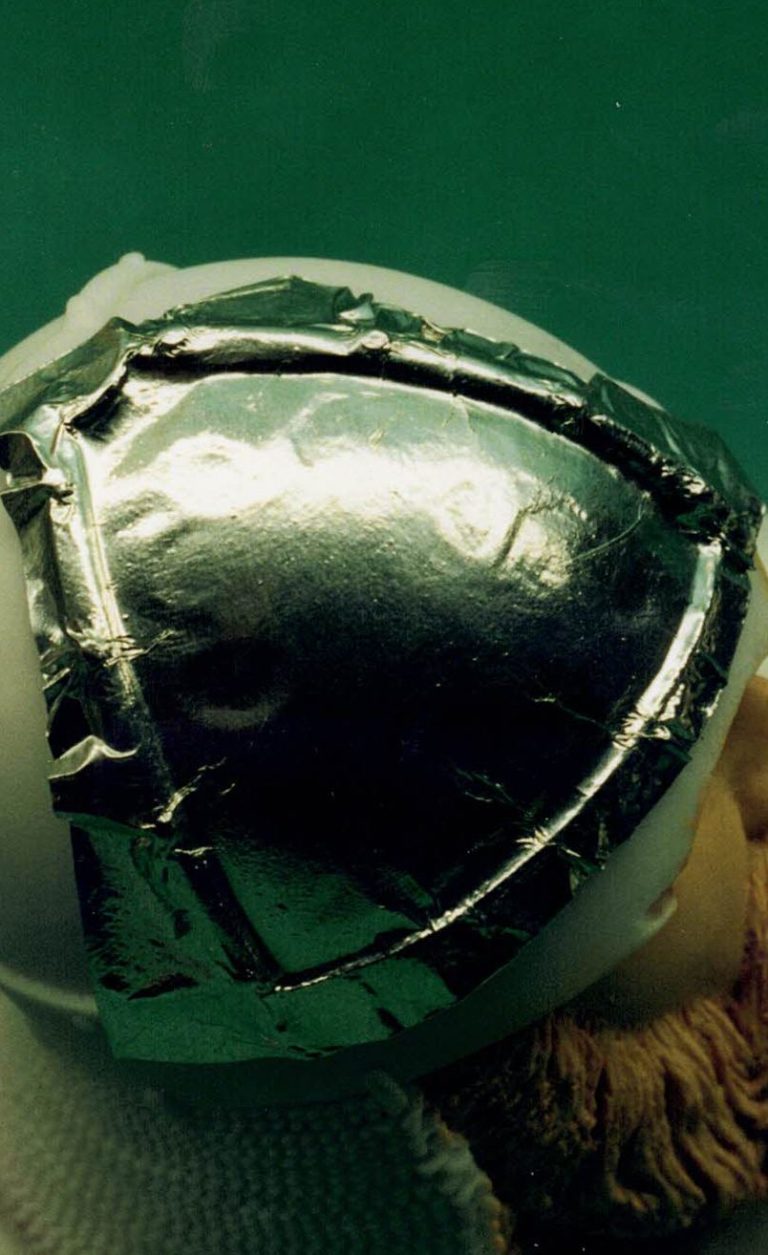
Sounds good eh ? Well I'll be honest and mention that the stuff I was given was getting on in age - said to have been in my friends possession for about twenty years. The glue was a little iffy, but with the added layer of white wood glue, it adhered very well indeed. I used this type of foil on the crown of the helmet only.
For the brow band and the spectacles I used the second sample of foil I was given, this being " Plumbers Flashing". This is available from most DIY places and is used as a substitute for lead flashing for sealing roofs etc. It's a bit thicker than the Bare Metal Foil, but works just as well, although I did have to remove the self adhesive glue compound from the back of this material with white spirit as it was threatening to grab onto the foil that was already in place on the model and tear it out from its position.
Other than that, I've included a few pictures showing how the foil is applied, the captions explaining more fully.
The foil didn't require polishing as it was already fairly bright in both cases, and so painting could take place after a couple of nights drying time.
I decided to give a distinctly rusty patina to this helmet, an idea that would be carried on through to the armour too. For this I used an equal mix of Van Dyke Brown and Ivory Black oil paint which was applied to the helmet undiluted and then wiped and dabbed off using a soft cloth. This left a hammered / beaten finish to the metal foil, which I for one found pleasing.
The face I painted in my standard mix of flesh coloured acrylic covered by oil paint. The beard being done to depict a ginger / blonde by using burnt sienna as a deep shadow colour. Placing over the top of this light red and then yellow ochre and a few judicious touches of white.
The armour was painted with a mix of Humbrol enamels, these being "Rust Brown", Black and Silver. This gave a good starting point to a rusted metal colour, which was darkened in the recesses with a wash of the Van Dyke Brown / Black oil mix and then dry brushed with Games Workshop "Chainmail" followed by a few light additions of silver ink.
The only fiddly bit - if that's what you can call it on a figure this size - was the collar. How the chap who casts these gets them out of the mould with such a massive undercut I do not know.
However, there's quite a bit of detail on this area, which I though would look good if it was done in similar colours to the cloak. So what I did was use a dark brown for the swirling pattern, adding some minimal highlights with Alazarin Crimson, and used a linen type of creamy colour for the background. It was a little awkward getting in under the beard detail, but the finished effect was well worth the effort.
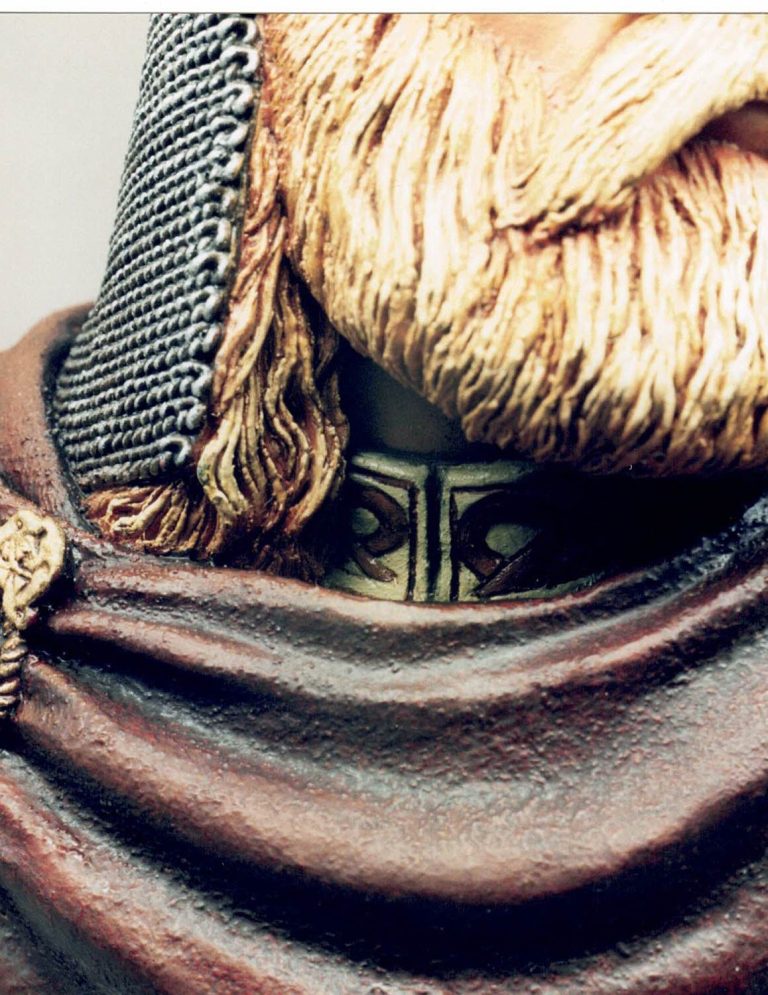
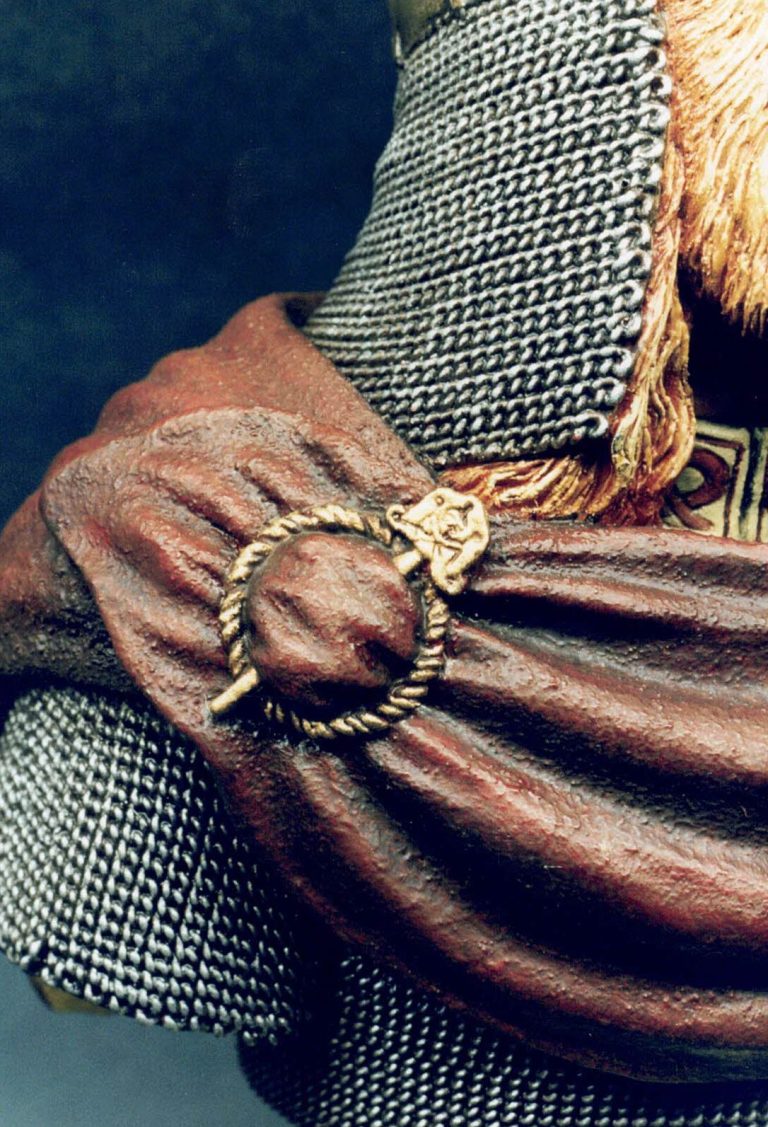
Now for the cloak. I was inspired by yet another depiction in the Brasseys Barbarian Warrior book. This time by the colour of one of the cloaks worn by the one of the re-enactors, namely the one seen on pages.......... I thought this colour of brown and cream would probably look good with the rusty brown helmet and armour, not to mention the ginger / blonde of the beard.
So after an undercoat of a suitable brown, the main body of the cloak was painted with Brown Madder Alazarin oils, working shadows into this with Burnt Umber, and after that adding a few highlights with an Alazarin Crimson / Light Red mix. The lining of the cloak was undercoated in Sand acrylic, finishing this off with yellow ochre oils, shaded with Burnt Umber , and highlights provided with Titanium White.
Finally to the base. Now this I must admit was going to be a lovely antiqued bronze / gold colour. I'd even airbrushed the final coats of gold flecking onto the base to get a nice even colouration. I decided to protect it though with some varnish, electing to use a satin varnish rather than a gloss one.
The first coat went on smoothly enough, and after waiting a couple of hours I put on a second coat to be sure. Yes you guessed it, Sod and his law came a calling, and the second coat of varnish decided to make the underlying paint go all crackly.
Shaking my head in disgust at the general unfairness of life, I removed all the paint, and contemplated what was to be done.
White that would be my saviour. I'd painted some stonework on a Greek model white, and then shaded it with Raw Umber this was a couple of years ago, and it still looked a fair representation of marble even now.
O.K. Vikings wouldn't have much in the way of marble, so there'd be nodirect connection, but needs must. Anyway the stated paints were used, these being an aerosol white primer a la car body spray, followed by a white acrylic brush painted on to protest the primer from the oil paint. Once dry the oil paint - Raw Umber - was added, painting this on neat from the tube, and was then wiped and dabbed off with the generic soft, dust free cloth. And viola, not marble at all, but ivory.
Yes, in this scale, and because of the slight satin finish of the white acrylic, this really looked like ivory. In fact I'm more pleased with the finished article now, than if the original gold had turned out. But then I would say that wouldn't I ! Anyway it just goes to show that disasters can be averted, and luck does ( occasionally ) smile on a modeller or two.

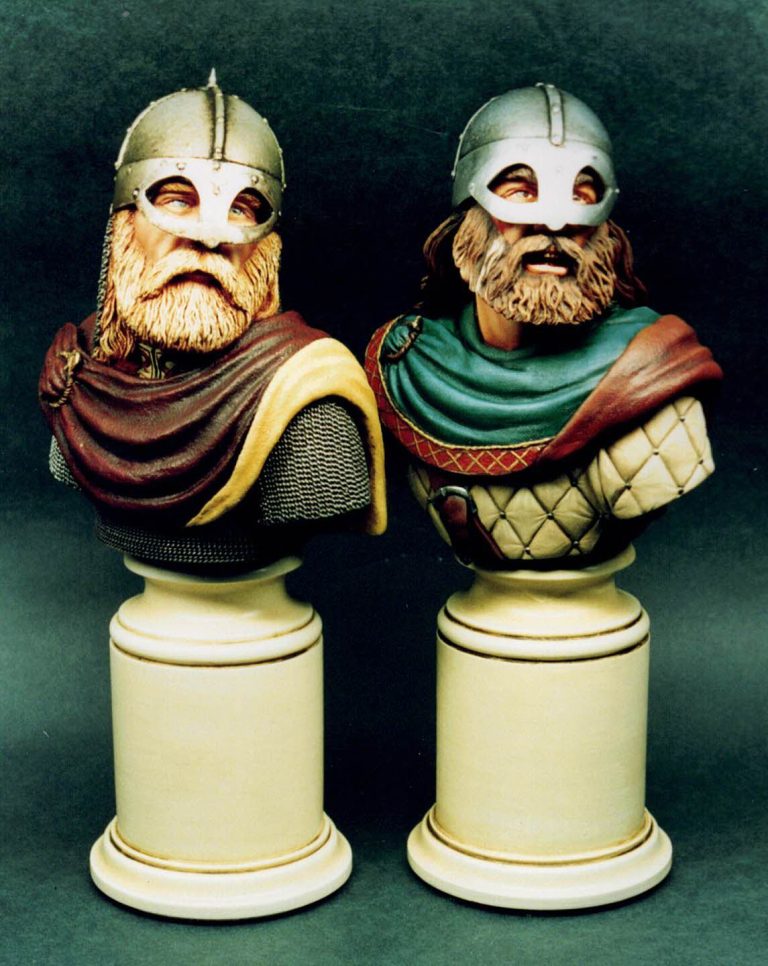
O.K. then what's the verdict on this kit. Well I said it at the start and I'll say it again, these are all very large pieces.
They all look good and this is definitely no exception. Is it better. Well, let's say that's for me to know, and you to make your own mind up about. If you like the subject matter of any of these models from either the hands of Dave Gerrett or Pete Morton, then I don't think you'll be in the least bit disappointed if you commit to buying them.
My thanks to Dave Gerrett of Fort Royal Review for supplying the review sample.
A footnote in 2025
Shown to the left are both Viking busts, the right hand one being the Pete Morton offering,
It's twenty-five years since these were released for sale, and also since I painted them. Sadly in that time Fort Royal Review has ceased to trade and both sculptors - Dave Gerrit and Pete Morton - have passed away.
Getting hold of any of this series of busts is probably very near impossible, and I feel very lucky to have them.
RIP Dave and Pete, you are both missed, not simply for your brilliant sculpting, mould making and casting, but also for the characters you were.
Cetero oporteat sensibus his eu. Has ex vidisse perpetua, vis partem mollis mandamus at. Ea nam legere mentitum prodesset, no quo lucilius liberavisse, te oratio debitis omittantur eos. Sea ea iusto detracto, ut scripta sapientem suavitate cum, nam deleniti perpetua intellegam an. Ei per officiis detraxit probatus, vim at graecis tincidunt.
